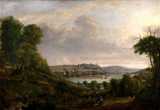
 |
 |
| Looking North from Forest Hills, West Covington Taken by Ira Beam, July 4, 1906 |
West Covington,
1899 engraving by J. L. Trout |
Painting by Kate Reno Miller Painting (1874-1929)
Maybe from Devou? Maybe from Eden Park?
| Barber and Candy Shop, 1923, at Altamont and John Streets in the photo, l-r, Gus Sheehan, Leo Mueller, and Jim Finke |
 |
 |
| Highway Avenue, going toward Covington, from Hayman Street. Hayman street was renamed Altamont. | |
| Several of West Covington's streets were re-named in 1917. | |
 |
 |
| Highway Avenue, in the 1937 Flood | Bricks for Highway Avenue, Kentucky Post, March 31, 1915 |
 |
 |
| A West Covington Methodist Episcopal Promotional piece |
St. John's Congregational in West Covington |
History of St. John's Congregational Church of West Covington is here. (pdf) |
|
Aerial of Highway Avenue
From Forrest Hills
unknown artist, c. 1845
Across from Cincinnati (West Covington, Ky.), 1888
Louis Charles Vogt (1864-1939) was a noted Cincinnati painter
who studied with Duveneck.
 |
 |
 |
| As the Union Methodist Church | Original Epworth Methodist | New Epworth Methodist |
| History of Epworth is here. | Dedication Program (pdf) |
West Covington residences on the National Register of Historic places, complete with photo's, history, and maps, include Kenny's Crossing, and the Moser Family houses. Both pdf's. |
Kid's at St. Ann's, 1908
 |
 |
 |
| St. Ann, West Covington | ||
| The Reverend Paul Ryan's History of the Diocese of Covington, Kentucky, from 1954, included a history of St. Ann's (West Covington) | ||
Did you know that St. Ann's was once a destination of pilgrims from far and wide? The laying of St. Anne's cornerstone, 1860. |
||

The Cincinnati Commercial Tribune, September 6, 1849
| West Covington legally established, in 1858. |  The Cincinnati Enquirer, November 8, 1916 |
“All of this good fortune inspired a lot of rumors about treasure buried all over this area. In West Covington, City Marshal Herman Barkhau complained that prospectors had dug hundreds of holes all over his town for 30 years or more. An old rumor claimed that robbers had stolen $50,000 from a Cincinnati bank during the Civil War and hid it – just before they were captured – on the Kentucky side of the river. On their release from prison they found that nature had erased all of their landmarks and they never recovered the loot.” Kentucky Post, October 5, 1899. . . . but still, they dig. |
|
| William Behringer, of Behringer-Crawford fame, created a journal to hold all of his postcards and pictures. It's here. (pdf) Good stuff! | History of West Covington from c. 1878, here (pdf). |
| Earlier names of West Covington were Economy, Forrest Hill, and Botany Hills. Details at this site. | Here's the Cincinnati Atlas' description of “Forrest Hill” from 1844. |
| “We can never be perfectly happy until the Covington reporters for the Cincinnati papers learn to distinguish the difference between Ludlow and West Covington - or Economy as they persist in calling it. Recently in an account of a trial at Covington, in which the plaintiff, defendant, and witnesses were from Ludlow - and there was the usual number of the latter - the whole credit of the affair was given to “Economy,” and the city Ludlow as being described as being “at the foot of Economy Hill.” from the Ludlow Reporter, October 3, 1874. | |
| “Originally known as Economy, West Covington is probably the oldest of the three early suburbs. Overlooking the Ohio River next to Ludlow, West Covington was platted as a town in 1846, according to an 1893 account. According to a 1904-05 directory, West Covington’s city hall, public school and library were on the southwest corner of Main and Taylor streets. That intersection now is Altamont and Alberta streets. The end of West Covington as an independent city came in 1916 when annexation by Covington was placed on the ballot. A majority of West Covington’s residents voted against the annexation, 304-130. But a state annexation law was stacked in Covington’s favor, requiring a 25 percent “Yes” vote. The annexation passed with 22 votes to spare.” Jeff Barkley, on Facebook, quoting Jim Reis' Pieces of the Past Vol. 1. | |
![]()





